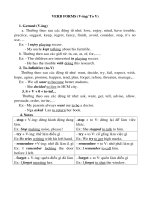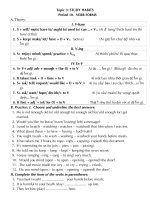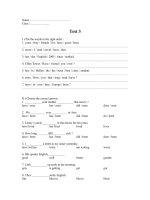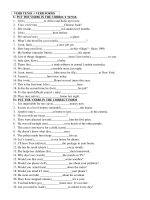Negative verb forms
Bạn đang xem bản rút gọn của tài liệu. Xem và tải ngay bản đầy đủ của tài liệu tại đây (16.35 KB, 2 trang )
Negative verb forms
The negative verb forms are made by putting not after an auxiliary verb.
She has invited us. (Affirmative)
She has not invited us. (Negative)
It was raining. (Affirmative)
It was not raining. (Negative)
She can knit. (Affirmative)
She cannot knit. (Negative)
If there is no auxiliary verb, do is used to make the negative verb forms.
I like reading. (Affirmative)
I do not like reading. (Negative)
Note that do is followed by an infinitive without to.
She didn’t come. (NOT She didn’t to come.)
Do is not normally used if there is another auxiliary verb.
You should not go. (NOT You don’t should go.)
Infinitives and -ing forms
The negative forms of infinitives and -ing forms are made by putting not before them. Do is not used.
The best thing about weekends is not working.
Not can be put with other parts of a clause, not just the verb.
Ask John, not his father.
Come early, but not before six.
We do not usually use not with the subject. Instead we use a structure with it.
It was not John who broke the window, but his brother. (NOT Not John broke the window, but his brother.)
Other negative words
Not isn’t the only word that can make a clause negative. There are some other negative words too. Examples
are: never, hardly, seldom, rarely etc.
Compare:
He does not work.
He hardly ever works.
He never works.
He seldom works.
Non-assertive words
We do not normally use words like some, somebody, something etc in negative clauses. Instead, we use
non-assertive words like any, anybody, anything etc.
I have caught some fish.
I haven’t caught any fish.
Stay on top of your writing! Download our grammar guide from www.englishgrammar.org to stay up-to-date.
Powered by TCPDF (www.tcpdf.org)









